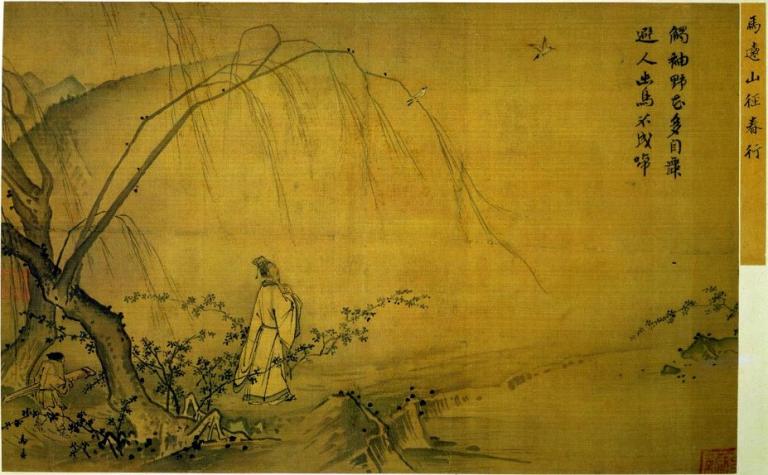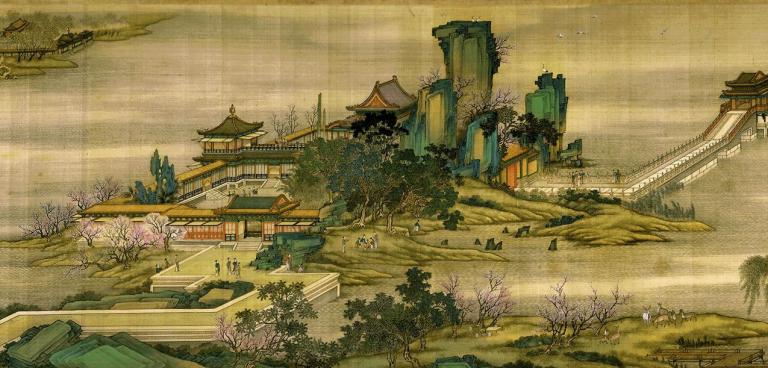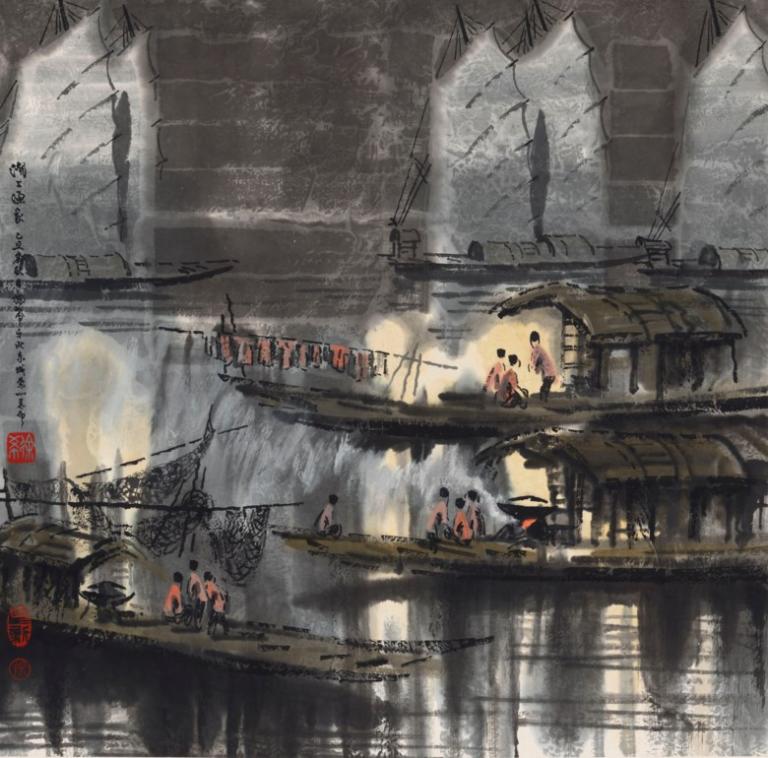Dynasties and Traditional Chinese Painting
8 min readPainting in Primitive Times
In the Paleolithic Age,there appeared Rock Painting in China.In the Neolithic Age,rock paintings began to show regional features.Altogether there were four types:in the north grassland the rock paintings always depicted animals closely related to people’s lives,such as the wild horse,sheep,pig,cow,and others;in the northeast forest areas the paintings usuallydescribed the relationship between humans and animals;in the southeast coastal area,the paintings were usually abstract symbols;in then southwest mountainous areas,the paintings mainly focused on human figures.
In addition,there was pottery with two major types of paintings on them.One type was geometric patterns,consisting of various lines and dots,and the other was natural patterns,consisting of human figures,animals,plants,sceneries,and so on.

Painting in the Pre-Qin Period
China entered the Bronze Age in the 21st century BC.Until the 5th century BC,bronzes had been highly developed,and at this time the sophisticated bronzes were decorated with various patterns.During the period of the Xia and Shang Dynasties,the exaggerated patterns were complicated and frightening,mainly concerning legendary monsters.Later in the Western Zhou Dynasty,the patterns were simplified,and the functions of the patterns shifted from mystification to decoration.During the Spring and Autumn and Warring States Periods,the patterns on bronzes became much simpler and mainly concerned with human figures,animals,and plants.At the same time,Mural Painting and Lacquer Painting appeared.During the Warring Sates Period,Silk Painting came into being.This was the first time that the Chinese employed soft material for painting.Generally speaking,Silk Painting was related to death.Some experts presumed the figures in the painting represented people buried in tombs,and the picture symbolized their souls rising up to heaven.Paintings on silk continued to develop until paper was invented,and gradually died out after the Eastern Han Dynasty.
Painting in the Qin and Han Dynasties
With a span of 14 years,the Qin Dynasty left only a few paintings.However,the excavated murals exhibit the skillful painting techniques of these ancient people.During the Han Dynasty,Silk Painting,Tomb Mural and Stone Engraving were the three most representative types of paintings.Silk paintings appeared in the Warring States and reached their artistic peak in the Western Han Dynasty.The painting had become richer in content and color,and the depiction of figures had become more vivid.Most of the silk paintings were discovered in the Picture 9-6Silk Painting MawangduiTomb in Hunan Province and Jinqueshan Discovered in Mawangdui Tomb in Shandong Province.Like the paintings in previous dynasties,the contents were still related to death.
Though both appeared in tombs,the content of tomb murals was much richer than that of silk paintings.Besides the wishes of rising to heaven,the murals also covered a wide range of topics,from ordinary life to historic and legendry stories.The mural paintings were not as exquisite assilk paintings in painting techniques,but they fully depicted the essence of their figures.Stone engravings also became popular during the Han Dynasty,as they were considered more enduring than the murals.Additionally,stone engravings were always carved with stories concerning the conservative theories for the interest of the rulers,such as loyalty,fealty,and so on.
Painting in the Wei and Jin Period and Southern and Northern Dynasties
During the Wei and Jin Period and Southern and Northern Dynasties,the concept of art for the sake of its own intrinsic beauty gradually developed,with human beings as the maior obiects.
Consequently,Figure Painting was in its prime.3 Figure Painting covered larger topics and focused on revealing the spirit of characters rather than their appearance.The famous painter and art theorist Gu Kaizhi(348-409)pointed out that more attention should be paid not only to the external shapes of figures,but also to their internal quality.Additionally,Figure Painting was imbued with an air of elegance and refined beauty.
Landscape Painting served as the backdrop or embellishment of Figure Painting in previous dynasties,and it wasn’t considered an independent school of painting in the Jin Dynasty.
Landscape Painting was deeply rooted in Chinese traditional culture.The Chinese have long believed in“the harmony between heaven and man”,which means that human beings can feel nature and therefore should be in a harmonious relationship with it.Landscape Painting became a good carrier for painters to express themselves,and more painters were encouraged to turn their attention to the depiction of landscape in painting.Flower-and-bird Painting then was in its infancy,and there were almost no theories concerning this type of painting.
As Buddhism was introduced to China at the beginning of the Eastern Han Dynasty,various types of religious paintings gradually gained popularity,and there were many famous carvings on grottoes and temple buildings that have lasted until today,such as Dunhuang Grotto.
In the beginning,Buddha,Bodhisattva,and Buddhist stories were the major topics.
Later,Chinese gods and goddesses were absorbed as new topics.It is interesting to see the Buddha and traditional Chinese gods appear at the same site.

Painting in the Sui and Tang Dynasties
The Sui and Tang Dynasties witnessed another peak of Figure Painting.There were many famous painters,among whom Zhang Xuan(713-741)and Zhou Fang(the 8th century)were good at portraying court ladies. This was the first time contemporary women were used as subjects in paintings,and the works were of special importance in Chinese painting history.Landscape Painting also matured quickly during the Tang Dynasty.Landscape Painting then was rich in color and carefully drawn,leading to the appellation“gold mountain and blue-green water landscape” and revealing the luxurious life of the time.Contrary to the rich colored Landscape Painting,Wu Daozi(680-759),a great reformer of Landscape Painting,put more emphasis on the lines.His paintings were commented as possessing lines and no washes of ink.In addition,the technique of applying washes of monochrome ink also developed.One representative was Wang Wei,who employed only ink to express plain scenery and peace of mind.During the Tang Dynasty,Flowerand-bird Painting eventually became an independent school and developed an unprecedented level of excellence.There were two major types:one featured rich scolor and the other was characterized by the natural wildness.
Murals then mainly existed in Buddhist and:Taoist temples,grottoes,and tombs.Temple murals mostly appeared in the central China,Sichuan and Tibet,each with their own regional features.Picure 97,Dunluang Moeao Groto Mural The representatives of grotto murals were Mogao Grotto of Dunhuang,and those in the Xinjiang areas.These murals were mostly of religious content,combining some exotic art elements because of the culture exchanged between China and foreign countries.The tomb murals then boasted the social status of the dead and their luxurious lives when alive.Most of the famous tomb murals were discovered in today’s Shaanxi Province,since the capital of the Tang Dynasty lay in today’s Xi’an,called Chang’an then.
Painting in the Song and Yuan Dynasties
Landscape painters in the Song Dynasty continued the traditions passed down from the previous dynasties.In the north,the paintings were of a rugged,steep and precipitous style,and in the south the paintings were of alluring,misty and elegant flavors.There were four great landscape painters respectively in the north and south of China then.Figure Painting in the Song featured religious themes and lives of both the literati and the common civilians.Some of the flower-and-bird paintings revealed the natural wilderness,and others were rich in color,exhibiting the riches and honor.The paintings at this time were not only accurately depicted in shape and manner,but their internal substance,emotions,ideas,and aspirations were also captured by the painters.During the Song Dynasty,there were special imperial art academies to serve the loyal family,among which the painting and calligraphy institutes were of the most importance.
Landscape Painting of the Yuan Dynasty held a very important position in the history of Chinese landscape painting.The“Four Great Painters”,Huang Gongwang ,Ni Zan ,Wu Zhen ,and Wang Meng,represented the highest level of Landscape Painting.Their works cast enormous influence on the landscape paintings of the following generations.The Figure Painting during the Yuan continued the tradition of previous times and there was not much progress.The Flower-and-bird Painting fell into two types:one was the continuation of the traditional style,and the other was related to literati.The common subjects were so-called“four gentlemen”,including plum,orchid,bamboo,and chrysanthemum,embodying the noble qualities of the ideal Confucian gentleman,which were modesty,purity and integrity.Scholar artists became the leading figures in painting.Paintings turned to express more about artists’personalities,thoughts and emotions.7 They were characterized by simplicity,transcendence,and elegance.
Painting in the Ming and Qing Dynasties
At the beginning of the Ming Dynasty,Zhejiang painting school entered the mainstream.It followed the tradition of the Southern Song Dynasty and developed the art of ink washing painting.8 The middle of the Ming Dynasty saw the rise of the Wumen Painting School ,which emerged in Suzhou,Jiangsu Province.In the late Ming and early Qing Dynasties,Literati Painting flourished with ever increasing vigor.Some painters copied the styles of earlier painters for study,and other painters composed independently,expressing their creativity and personality.By the middle of the Qing,more painters practiced a personal form of art,carrying a strong message of independence.As more missionaries came to China,Western oil painting was introduced.The Western painting techniques were particularly admired by the emperors,and soon the court painters mastered the rudiments of Western linear perspective andchiaroscuro modeling,creating a new form of painting that combined Western-style realism with traditional brush painting.One representative was the Italian Jesuit Giuseppe Castiglione(1688-1766),who lived in China for over five decades and served as the court painter.Known to the Chinese as Lang Shining,he created a synthesis of European methods and traditional Chinese media and formats.
Painting in the Republic of China
During the period of the Republic of China,two major painting schools became prominent:Shanghai School and Lingnan School. The Shanghai Painting School originated in Shanghai,the most prosperous city of that time and the gathering place for numerous painters.The painting school,which focused more on the flower-and-bird paintings,played an important role in the transition of Chinese traditional painting from a classical art form to a modern one.Inspired by the New Culture Movement,the Chinese learnt more from Western art.Many outstanding painters emerged,and their paintings were good examples of combining both Chinese and Western styles.Famous painters included Xu Beihong(1895-1953),QiBaishi(1864-1957),Huang Binhong(1865-1955),Zhang Daqian(1899-1983),and so on.Lingnan Painting School referred to Guangdong paintings in general.This type of painting retained the exquisiteness of traditional Chinese painting and adopted the techniques of Western painting and created a unique style harmoniously blending Eastern and Western art.
Painting in China Today
With the founding of the People’s Republic of China,traditional paintings were reformed to “serve the people.”Painting from life rather than copying ancient masterpieces became the principal source of inspiration for most artists,and the paintings mainly portrayed ordinary people or sang the praises of the majesty of the motherland.During the Cultural Revolution the traditional painting was despised,and paintings became the means of governmentpropaganda.Since the policy of reform and opening was implemented in China,a movement,termed“Scar Painting”or“Painting of the Wounded” appeared.This type of painting addressed a number of painful issues,such as the destruction and sense of loss generated by the Cultural Revolution.After the 1990s,both traditional and Western styles flourished,with a large market potential.









